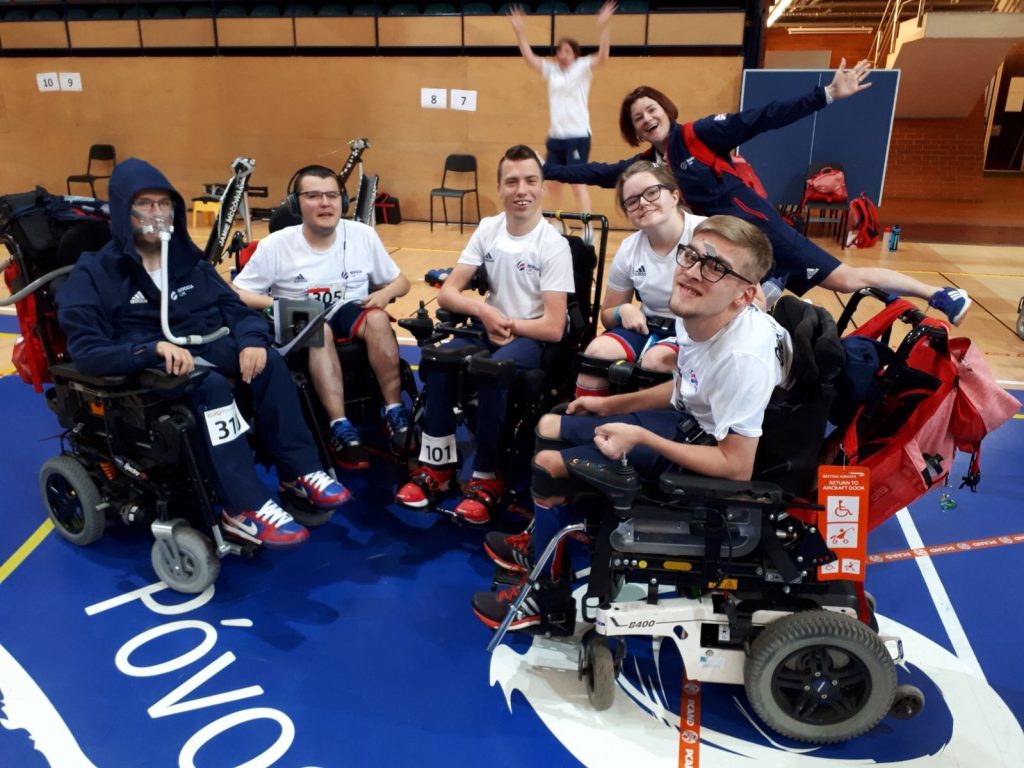Boccia UK continues to thrive with the help and expertise of an interdisciplinary EIS support team
The recent Boccia BISFed European Championships in Portugal saw Great Britain come away with a trio of individual gold medals in three of the classes and two silver pairs medals- an amazing achievement for the athletes and the support staff.
We spoke to EIS Senior Physiotherapist and Paralympic Technical Lead Dawn Ibrahim, who speaks about the multidisciplinary approach of the sport, why she loves the challenge of working in Boccia and how she uses expertise in her Technical Lead role to help develop up and coming practitioners.
Firstly, Dawn spoke about the recent success at the 2017 European Championships.
“We came away with three individual gold medals in three of the classes; David Smith won BC1 Gold, Jamie McCowan with assistant Linda McCowan took the BC3 title and Stephen McGuire achieved top spot in BC4 – plus we also got two silver pairs medals in two classes so five medals in total which is a brilliant achievement,” said Dawn.
“It was a really successful tournament and a great way to finish a long competitive season. All our athletes were really well prepared prior to going out there and the venue was familiar and comfortable for us and the athletes as we have been there many times before. What was especially noticeable was that we have a well practiced support and coaching team within the sport now and we all understand each other’s roles and responsibilities during the competition environment.”
Having a fully functioning multi-disciplinary team has been a key factor in the recent success in Boccia and has benefitted the sport as a whole, as Dawn explains.
“The athletes who play Boccia present with a wide range of complex disabilities and impairments including those with neurological impairments. Not one athlete presents the same and we have athletes with both neurological impairments and tonal change as well as those whose primary functional impairment is that of muscle weakness, so our programme and performance threats for each athlete will be quite different.

“We’re a small team of practioners and coaches but we all work really closely together to develop individual athlete plans which align to the ‘What It Takes To Win’ model in the sport. We constantly track and monitor athlete performance and this information is shared across the whole team so each individual athlete has a coordinated plan. Physiotherapy and strength and conditioning are well integrated and an athletes’ physical goals and objectives are aligned to the sport specific performance goals. Overall, each training programme is informed by the whole team so it might mean some technical analysis, some coach input, athlete input and an interdisciplinary discussion between all the disciplines.
“We aim to address all the performance threats and mitigate the risk of injury and illness and also look at specific areas to enhance performance. That knowledge base comes from an integrated working environment and allows athlete’s individual programmes to be really specific.”
Dawn continued to clarify in more depth about how different athlete’s plans in Paralympic sport can be.
“Each individual athlete on the The World Class Performance Programme has a physical programme that will include daily conditioning to address postural control, core activation, flexibility, strength and control and a hydrotherapy programme and specific gym conditioning programme where appropriate. Each individual’s programme will have key elements specific for them.
“For example, athletes who throw will focus on the core and shoulder whereas athletes who use a ramp to deliver the ball using a head pointer will focus on postural control and cervical flexibility, strength and control. Athletes will also have specific indiviualised physical preparation and recovery strategies.”
As with every sport, an athlete will come up against injury at some stage in their career and Dawn describes how these injuries can come about and how they are dealt with in Boccia.
“We are really fortunate that we don’t have that many injuries in Boccia but common problems are associated with an athlete’s underlying impairment. Our athletes with muscular dystrophy for example will have associated underlying muscle weakness and reduced muscular control which can lead to imbalance and instability issues which can cause injury. An athlete’s individual strength and conditioning programme and physiotherapy interventions will look to mitigate against this.”

Having worked in elite sport in the EIS for over 10 years and with Boccia for over eight years, Dawn tells us how adding the Paralympic Technical Lead role to her applied work has allowed her to help develop up and coming practitioners.
“My role as a Paralympic Technical Lead involves working proactively across a number of Paralympic sports to help deliver their athlete health strategy, to support practitioners to align with this strategy and develop their individual objectives whilst identifying their own performance development needs. This includes helping practitioners to achieve their best and mentoring them as well as providing technical support.”
So having worked in an array of different sports, why does Dawn enjoy working in Boccia?
“I have always had a passion for neurology and a passion for musculoskeletal physiotherapy so working in para sport gives me the best of both worlds. I also love the challenge that para sport offers. The technical lead role also offers me the opportunity to develop other practitioners and to develop myself at the same time which is why I love it.
“This enjoyment also comes from working for the EIS. It’s about the people I work with and being part of a team that has a common goal and being involved in an environment which is filled with motivated athletes and practitioners. This network of practitioners also acts as a support system which when you have a specific problem or challenge enables you to call upon that network of expertise to find a solution.”